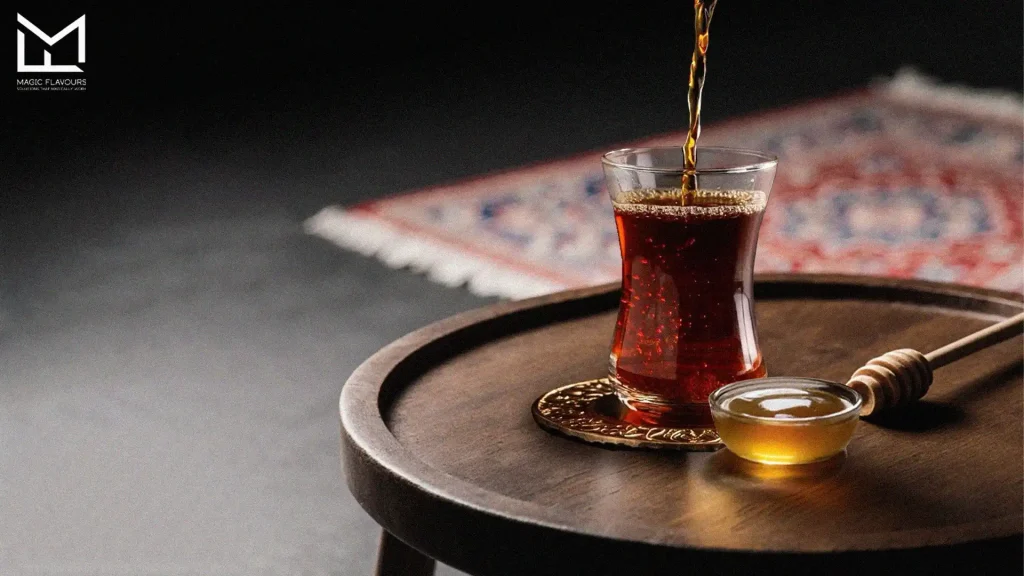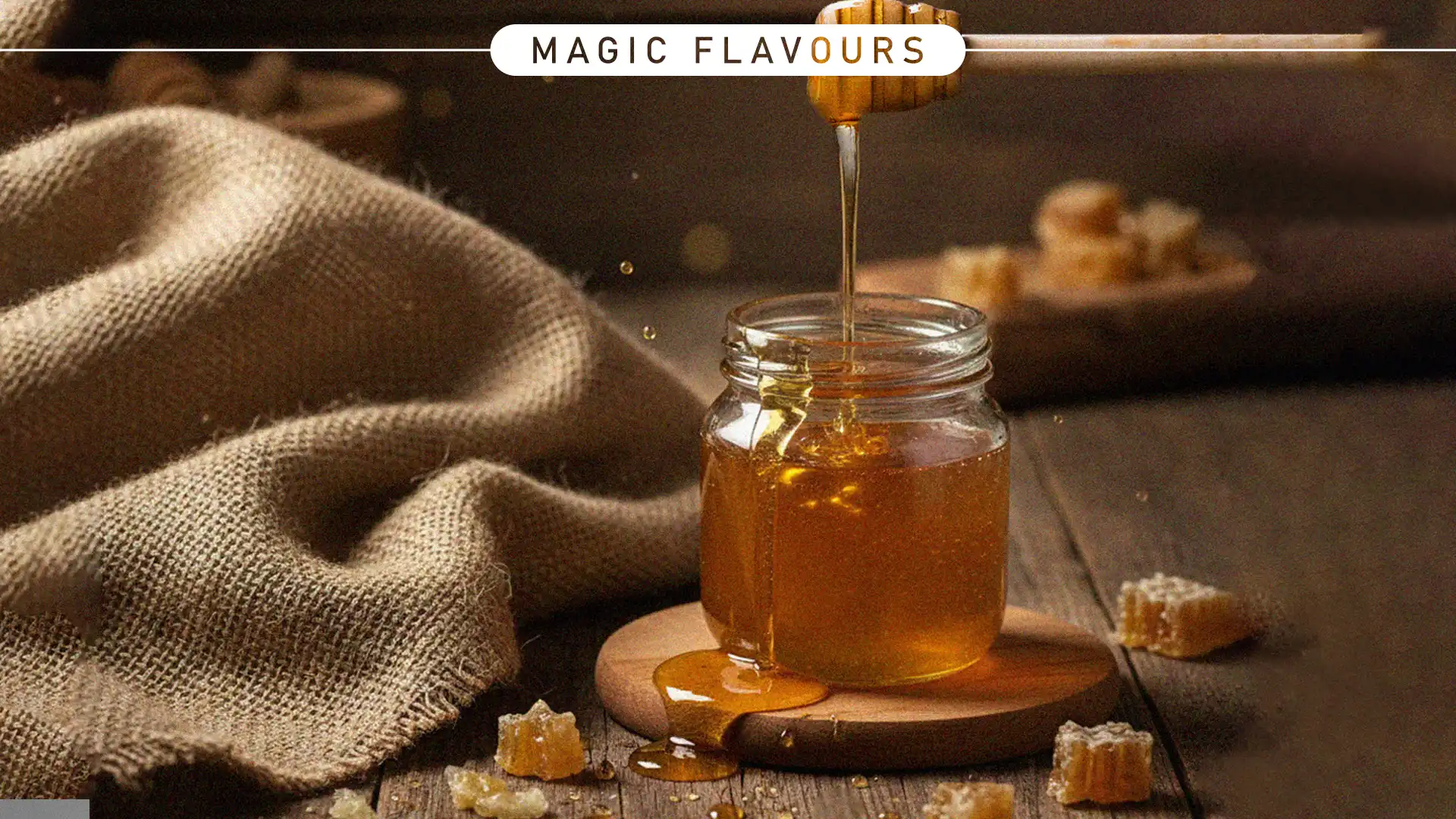1. Introduction to Honey Flavor
What Is Honey?
Honey Flavor: First, honey is a natural sweetener made by bees. Then, bees collect nectar from flowers and store it in hives. Because enzymes break down the nectar, it turns into thick, golden honey.
Next, honey contains sugars like glucose and fructose. So, it provides quick energy and a smooth texture. Also, it includes trace vitamins, minerals, and antioxidants.
Finally, honey varies by flower source and region. Because of this, each type has a unique taste and color. Its natural origin makes it a prized ingredient worldwide.
Origins and Cultural Importance of Honey Flavor
First, honey has been used for thousands of years. Then, ancient Egyptians offered it to gods and used it in medicine. Because of its sweetness, it symbolized purity and abundance.
Next, Greeks and Romans valued honey in cooking and healing. So, they used it in sauces, drinks, and skin treatments. Also, honey appeared in religious texts and sacred rituals.
Finally, honey remains important in many cultures today. Because of this, it features in festivals, folk remedies, and traditional recipes. Its legacy reflects both flavor and spiritual meaning.
Overview of Honey’s Flavor Profile
First, honey tastes sweet, floral, and slightly earthy. Then, its flavor depends on the nectar source and region. Because of this, clover honey feels mild, while buckwheat tastes bold.
Next, honey offers notes of fruit, spice, or herbs. So, it pairs well with many ingredients in cooking. Also, its aroma adds depth to both sweet and savory dishes.
Finally, honey’s texture affects its flavor experience. Because of this, thicker honey feels richer and more intense. Its flavor profile makes it versatile and beloved worldwide.
2. Chemical Composition and Taste Notes of Honey Flavor
Natural Sugars and Aromatic Compounds of Honey Flavor

First, honey contains natural sugars like glucose and fructose. Then, these sugars give honey its sweet taste and smooth texture. Because they digest quickly, honey provides fast energy.
Next, honey includes aromatic compounds from flower nectar. So, these compounds shape its scent and flavor. Also, enzymes from bees help develop honey’s complexity.
Finally, honey holds trace minerals and acids. Because of this, it tastes slightly tangy or earthy. Its chemistry makes each spoonful rich and layered.
How Floral Sources Affect Honey Flavor
First, honey’s flavor depends on the flowers bees visit. Then, clover honey tastes mild and clean. Because of this, it suits baking and tea.
Next, lavender honey feels floral and slightly herbal. So, it works well in desserts and dressings. Also, buckwheat honey tastes bold and molasses-like.
Finally, wildflower honey blends many nectar sources. Because of this, its taste changes with seasons and regions. Floral origin gives honey its unique identity.
Raw vs. Processed Honey
First, raw honey comes straight from the hive. Then, it’s strained but not heated or filtered. Because of this, it keeps enzymes and antioxidants.
Next, processed honey is heated and filtered. So, it looks clearer and lasts longer. Also, it may lose some nutrients and flavor.
Finally, raw honey offers a richer taste. Because of this, many people prefer it for health and cooking. Choosing raw or processed depends on your needs.
3. Culinary Applications of Honey Flavor
Honey Flavor in Sweet Recipes
First, honey adds depth to cakes, cookies, and pastries. Then, bakers use it to replace sugar in moist, flavorful desserts. Because of its richness, it enhances chocolate, nuts, and fruits.
Next, honey works well in puddings and custards. So, it brings smooth texture and floral sweetness. Also, it pairs beautifully with cinnamon, vanilla, and citrus zest.
Finally, honey shines in glazes and frostings. Because of this, it creates glossy finishes and balanced sweetness. Its natural sugars caramelize gently in baked goods.
Honey Flavor in Beverages (Teas, Smoothies, Cocktails)
First, honey sweetens hot and iced teas. Then, it blends smoothly without overpowering herbal notes. Because of this, it’s a favorite in wellness drinks.
Next, honey adds flavor to smoothies and juices. So, it complements fruits like banana, mango, and berries. Also, it boosts energy and texture naturally.
Finally, honey appears in cocktails and mocktails. Because of this, it balances sour and bitter ingredients. Its floral notes elevate drinks like hot toddies and mojitos.
Honey Flavor in Savory Dishes and Marinades
First, honey enhances sauces and dressings. Then, it balances vinegar, mustard, and spices. Because of this, it works well in salads and slaws.
Next, honey adds depth to marinades for meat and fish. So, it helps create a golden crust when grilled or roasted. Also, it pairs with garlic, soy sauce, and chili.
Finally, honey appears in vegetable glazes and grain bowls. Because of this, it adds warmth and contrast. Its sweetness rounds out bold and earthy flavors.
Regional Cuisines Featuring Honey

First, Mediterranean cuisine uses honey in pastries and cheese dishes. Then, Greek and Turkish recipes feature honey with nuts and filo. Because of tradition, it appears in festive desserts.
Next, Middle Eastern dishes include honey in sauces and sweets. So, it blends with tahini, dates, and rosewater. Also, it’s used in celebratory meals and drinks.
Finally, Asian and African cuisines use honey in marinades and stews. Because of this, it adds balance to spicy and sour flavors. Its global presence shows honey’s culinary versatility.
4. Health Benefits and Traditional Uses of Honey Flavor
Honey in Folk Remedies and Ancient Medicine
First, honey has been used in healing for thousands of years. Then, ancient Egyptians applied it to wounds and burns. Because of its soothing nature, it helped reduce pain and infection.
Next, Greeks and Romans used honey in cough syrups. So, they mixed it with herbs to ease sore throats. Also, honey appeared in digestive tonics and skin treatments.
Finally, honey was part of Ayurvedic and Chinese medicine. Because of this, it supported immunity and balanced energy. Its role in folk remedies shows its lasting value.
Antibacterial and Antioxidant Properties of Honey Flavor
First, honey contains natural enzymes and hydrogen peroxide. Then, these compounds fight bacteria and prevent infection. Because of this, honey helps heal cuts and scrapes.
Next, honey offers antioxidants like flavonoids and polyphenols. So, it protects cells from damage and aging. Also, it supports heart health and reduces inflammation.
Finally, darker honey types contain more antioxidants. Because of this, buckwheat and manuka honey are popular in wellness. Its healing power comes from nature’s chemistry.
Modern Wellness and Functional Foods

First, honey appears in many wellness products today. Then, it’s added to teas, supplements, and energy bars. Because of its nutrients, it fits into healthy lifestyles.
Next, honey supports gut health and immunity. So, people use it in morning routines and detox drinks. Also, it’s blended with turmeric, ginger, and lemon.
Finally, honey is part of functional food trends. Because of this, it’s used for both flavor and benefits. Its gentle sweetness makes wellness feel enjoyable.
5. Pairing Honey with Other Flavors
Complementary Fruits, Nuts, and Spices
First, honey pairs well with citrus fruits like lemon and orange. Then, it blends smoothly with apples, pears, and berries. Because of this, it works in both fresh and baked dishes.
Next, honey complements nuts like almonds, walnuts, and pistachios. So, it adds sweetness to granola, salads, and pastries. Also, it balances the richness of nut butters and cheeses.
Finally, honey matches warm spices like cinnamon, ginger, and cardamom. Because of this, it enhances flavor in teas, cakes, and sauces. Its versatility makes it easy to mix and match.
Honey in Fusion and Gourmet Cuisine
First, chefs use honey in modern fusion recipes. Then, they blend it with soy sauce, chili, and lime. Because of this, it adds depth to Asian-inspired marinades.
Next, honey appears in Mediterranean and Middle Eastern dishes. So, it pairs with tahini, yogurt, and roasted meats. Also, it works in gourmet glazes and vinaigrettes.
Finally, honey elevates fine dining desserts and cocktails. Because of this, it’s infused with herbs or aged in barrels. Its flavor adds elegance and complexity to gourmet creations.
Balancing Sweetness and Depth in Recipes

First, honey’s sweetness needs balance in cooking. Then, chefs add acid like lemon juice or vinegar. Because of this, the dish feels bright and layered.
Next, salt and spice help ground honey’s flavor. So, they prevent recipes from tasting too sugary. Also, bitter notes like coffee or cocoa add contrast.
Finally, use honey in small amounts for subtle sweetness. Because of this, it won’t overpower other ingredients. Balancing honey creates harmony in every bite.
6. Buying, Storing, and Using Honey Flavor
How to Choose Quality Honey
First, look for honey labeled raw and unfiltered. Then, check for origin and floral source on the label. Because of this, you’ll know what flavor to expect.
Next, choose honey with a thick texture and golden color. So, avoid overly clear or watery types. Also, local honey often offers better taste and freshness.
Finally, buy from trusted producers or farmers’ markets. Because of this, you support ethical sourcing and quality. Good honey starts with careful harvesting and minimal processing.
Storage Tips for Raw and Infused Honey
First, store honey in a sealed glass jar. Then, keep it in a cool, dry place away from sunlight. Because heat and light affect flavor, storage matters.
Next, raw honey may crystallize over time. So, warm the jar gently to return it to liquid form. Also, never microwave honey, as it damages nutrients.
Finally, infused honey needs extra care. Because of this, refrigerate it if it contains fresh herbs or fruit. Proper storage keeps honey safe and flavorful.
Preparation Techniques (Drizzling, Cooking, Mixing)

First, drizzle honey over toast, yogurt, or fruit. Then, use it as a natural sweetener in breakfast dishes. Because of its smooth texture, it spreads easily.
Next, cook with honey in sauces and marinades. So, add it early to help flavors blend and caramelize. Also, balance it with acid or spice for depth.
Finally, mix honey into drinks and dressings. Because of this, it dissolves well in warm liquids. Its versatility makes it perfect for everyday use.
7. Honey in Non-Culinary Products
Honey in Skincare and Cosmetics
First, honey hydrates and softens the skin naturally. Then, it locks in moisture and improves texture. Because of this, it appears in creams, masks, and cleansers.
Next, honey calms redness and irritation. So, it suits sensitive and acne-prone skin types. Also, its antibacterial properties help prevent breakouts.
Finally, honey adds glow and smoothness. Because of this, it’s used in lip balms and exfoliators. Its gentle nature makes it a favorite in beauty routines.
Honey in Natural Remedies and Home Care
First, honey soothes sore throats and coughs. Then, people mix it with lemon or ginger for relief. Because of this, it’s a trusted home remedy.
Next, honey helps heal minor cuts and burns. So, it protects wounds and reduces infection. Also, it speeds up recovery with natural enzymes.
Finally, honey works in DIY cleaning and wellness blends. Because of this, it’s added to scrubs, salves, and herbal teas. Its versatility makes it useful beyond the kitchen.
8. Cultural and Symbolic Significance of Honey Flavor
Honey in Mythology and Religion
First, honey appears in many ancient myths and sacred texts. Then, Egyptians offered honey to gods as a symbol of purity. Because of this, it held spiritual and healing power.
Next, Greek mythology linked honey to divine food. So, it was called “ambrosia” and served to immortals. Also, bees were seen as messengers between worlds.
Finally, honey appears in the Bible and Quran. Because of this, it’s praised for its goodness and healing. Its role in religion reflects deep respect for nature’s gifts.
Honey in Festivals and Seasonal Traditions
First, honey plays a role in harvest and new year celebrations. Then, Jewish families eat apples with honey during Rosh Hashanah. Because of this, it symbolizes hope and sweetness for the year ahead.
Next, honey appears in wedding and fertility rituals. So, it’s used to bless couples and newborns. Also, it’s shared during seasonal feasts and family gatherings.
Finally, honey connects people to land and tradition. Because of this, it’s honored in folk songs and stories. Its presence in festivals shows how flavor meets meaning.
9. Conclusion
Recap of Honey’s Flavor and Versatility
First, honey offers sweet, floral, and earthy notes. Then, its flavor changes with flower type and region. Because of this, each variety feels unique and special.
Next, honey works in sweet and savory recipes. So, it appears in desserts, drinks, sauces, and marinades. Also, it blends well with fruits, nuts, and spices.
Finally, honey supports health and beauty. Because of this, it’s used in remedies, skincare, and wellness products. Its versatility makes it valuable in every part of life.
Final Thoughts on Embracing Honey Flavor in Everyday Life
First, honey brings flavor, comfort, and tradition. Then, try it in your meals, teas, or morning routines. Because of its gentle sweetness, it suits every taste.
Next, explore raw and local honey varieties. So, you’ll enjoy richer flavor and better nutrition. Also, support ethical producers and sustainable practices.
Finally, let honey inspire your cooking and self-care. Because of this, you’ll connect with nature and heritage. Embrace honey and enjoy its simple, golden magic.
